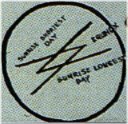|
TRANSLATIONS
In the Mnajdra temple the pillars up front serve to define the points of the solstices. Likewise, we remember, the trilithon on Tongatapu defined both the solstices and the equinoxes:
Therefore, evidence may point to ragi glyphs being associated with the solstices rather than with the equinoxes, and I arrive at a conclusion to change the text into: The subject is the year, with Aa1-3--4 presumably located before spring equinox. Personified ragi figures are running (and they have pointed 'beaks'). The new 'house' which will be ready a quarter later (at Ko Koró) needs two 'house posts'. They probably stand for the solstices - it is more reasonable to raise sky pillars when the sky stands still. Both solstice posts are presented already here (in winter), though, because they are the fundamental beams of the 'house' and they belong together. However, even if the ragi glyphs means pillars pushing the sky up (from a point where there must by a new motion, a new life), the two figures are running - i.e. the sky moves. Therefore the pillars in their hands cannot be the solstices. I cannot change the text, I will leave it as it stands: The subject is the year, with Aa1-3--4 presumably located around spring equinox. Personified ragi figures are running (and they have pointed 'beaks'). The new 'house' which will be ready a quarter later (at Ko Koró) needs two 'house posts'. They probably stand for the equinoxes. Both are presented already here, though, because they are the fundamental beams of the 'house'. The parallel glyphs in H/P/Q also have running persons:
Could the meaning of the running persons be to illustrate - as one effect of pushing hard against the sky roof - that it starts to 'run'? If so, then - after all - we should read the events to occur at the solstices. Furthermore, Te Pou (Sirius), is the star which makes the waters of the Nile start rising. In Haida Gwaii, 'early at dawn' ought to mean 'at the beginning of the solar year in midwinter', and the white seafoam suggests the moon:
'Slicing the hat in two' ought to be equivalent to Marduk dividing the 'night' in the middle. The Raven was then 'gone for a while' - which means he must wait until his time comes (at the beginning of the 2nd 'year'). If I have understood correctly, then the 'water' will rise beyond winter solstice, the first sign of movement and a promise of a fertile 'land'. And the primary factor should be Sirius. When the 'villagers' saw 'his face' it could mean they saw Sirius. In H/P/Q the heads of the running persons are shown en face, a sign of being in the middle (for instance at noon). In Tahua we see the opposite sign, presumably meaning 'not middle'. Maybe Tahua tells about the equinoxes while the H/P/Q texts document the solstices? The reason why in Aa1-3--4 we do not see the head en face may be the wish to show the pointed 'beaks'. Tara (thorn) glyphs have great open mouths and that we can see in Aa1-3--4 too. Once again we return to solstices rather than to equinoxes. I will now change the text into: The subject is the year, with Aa1-3--4 probably located at winter solstice. It is reasonable to raise sky pillars when the sky stands still. The new 'house' which will be ready half a year later (at Ko Koró) needs two 'house posts'. Personified ragi figures are running to set the sky in motion again. The following text must then be changed so that - viz. the winter 'year' - is deleted:
A problem is why the end-of-season numbers are different:
10 + 18 = 28, i.e. when sun 'disappears' ('falls on his face') around autumn equinox, it is an event in harmony with how moon disappears after 28 nights. 10 * 18 (= 36 / 2) + 18 * 10 (= 20 / 2) = 360. 4 quarters could equally well be 4 * 91 = 364, but neither 10 nor 18 are 'translatable' into a year with 364 nights. 28 could be related to the cycle of the sun by measuring the distance from new year to autumn equinox: 10 months ŕ 28 days = 280 which is comes close to autumn equinox and to the period of pregnancy. But then also P could measure the same distance: 28 periods with 10 days = 280. The rongorongo texts seem to everywhere blend moon and sun. 28 could therefore very well measure the solar cycle while strongly suggesting moon. If sun is associated with a person, being born, growing up etc, then the life of the sun could be represented by the stages of the moon, because these were also associated with the stages of life: "The Lunar Mansions once bore an important part in observational astronomy, especially in that of Arabia, China, and India, and of Khiva - the ancient Khorasmia - and Bokhara - the ancient Sogdiana; while recent research finds them well established in the Euphrates valley, Coptic Egypt and Persia ... They lay for the most part along the celestial equator or in the zodiac, varying in extent, although theoretically each was supposed to represent the length of the moon's daily motion in its orbit. They sometimes were twenty-seven, but usually twenty-eight days, and possibly long antedated the general constellations, or even the solar zodiac ... Their astrological characters were various, eleven being considered fortunate, ten the reverse, and seven of unceirtain influence; but each, at least in India, was associated with some occurrence of life ..." (Allen) |








